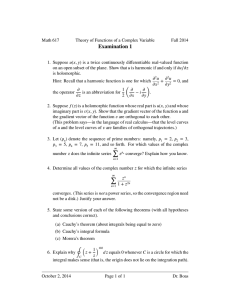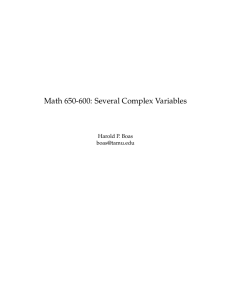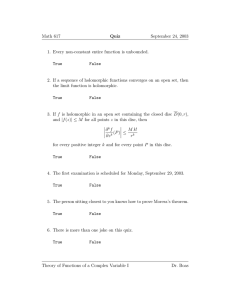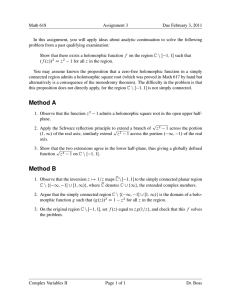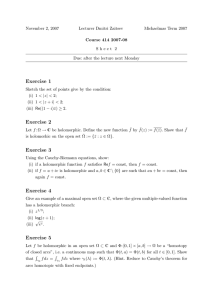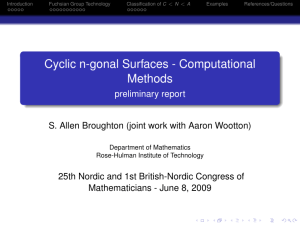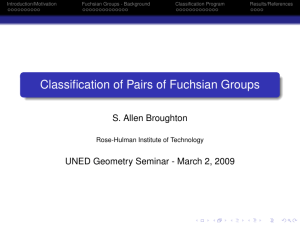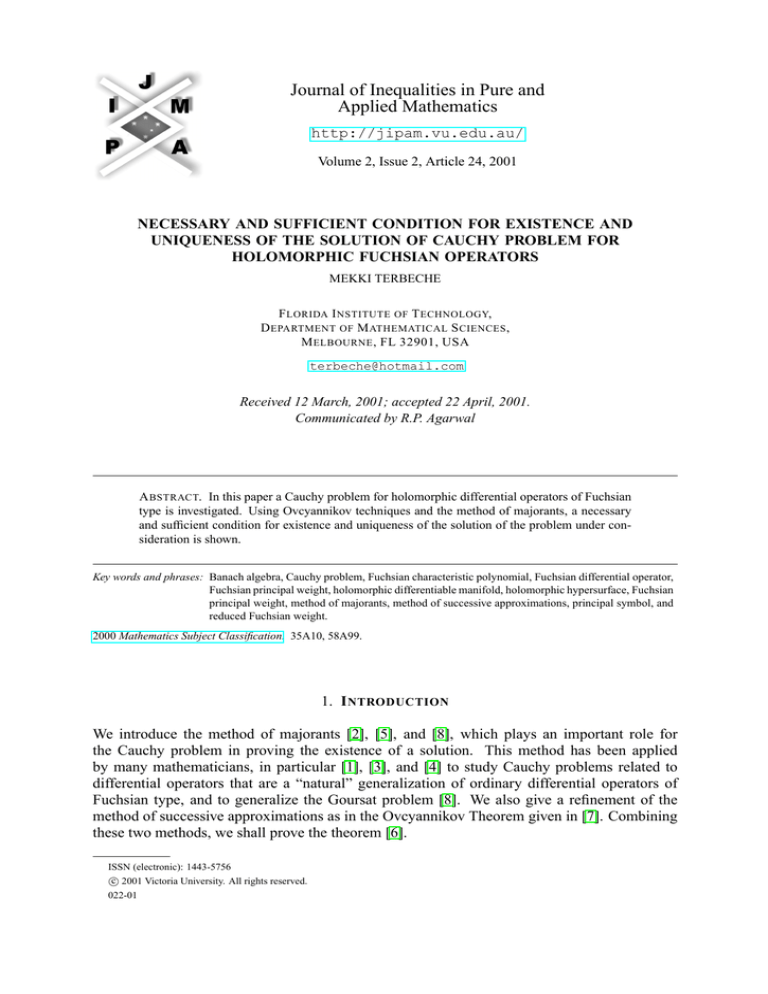
Journal of Inequalities in Pure and
Applied Mathematics
http://jipam.vu.edu.au/
Volume 2, Issue 2, Article 24, 2001
NECESSARY AND SUFFICIENT CONDITION FOR EXISTENCE AND
UNIQUENESS OF THE SOLUTION OF CAUCHY PROBLEM FOR
HOLOMORPHIC FUCHSIAN OPERATORS
MEKKI TERBECHE
F LORIDA I NSTITUTE OF T ECHNOLOGY,
D EPARTMENT OF M ATHEMATICAL S CIENCES ,
M ELBOURNE , FL 32901, USA
terbeche@hotmail.com
Received 12 March, 2001; accepted 22 April, 2001.
Communicated by R.P. Agarwal
A BSTRACT. In this paper a Cauchy problem for holomorphic differential operators of Fuchsian
type is investigated. Using Ovcyannikov techniques and the method of majorants, a necessary
and sufficient condition for existence and uniqueness of the solution of the problem under consideration is shown.
Key words and phrases: Banach algebra, Cauchy problem, Fuchsian characteristic polynomial, Fuchsian differential operator,
Fuchsian principal weight, holomorphic differentiable manifold, holomorphic hypersurface, Fuchsian
principal weight, method of majorants, method of successive approximations, principal symbol, and
reduced Fuchsian weight.
2000 Mathematics Subject Classification. 35A10, 58A99.
1. I NTRODUCTION
We introduce the method of majorants [2], [5], and [8], which plays an important role for
the Cauchy problem in proving the existence of a solution. This method has been applied
by many mathematicians, in particular [1], [3], and [4] to study Cauchy problems related to
differential operators that are a “natural” generalization of ordinary differential operators of
Fuchsian type, and to generalize the Goursat problem [8]. We also give a refinement of the
method of successive approximations as in the Ovcyannikov Theorem given in [7]. Combining
these two methods, we shall prove the theorem [6].
ISSN (electronic): 1443-5756
c 2001 Victoria University. All rights reserved.
022-01
2
M EKKI T ERBECHE
2. N OTATIONS AND D EFINITIONS
Let us denote
x = (x0 , x1 , . . . , xn ) ≡ (x0 , x0 ) ∈ R × Rn , where x0 = (x1 , . . . , xn ) ∈ Rn ,
ξ = (ξ0 , ξ1 , . . . , ξn ) ≡ (ξ0 , ξ 0 ) ∈ R × Rn , where ξ 0 = (ξ1 , . . . , ξn ) ∈ Rn ,
α = (α0 , α1 , . . . , αn ) ≡ (α0 , α0 ) ∈ N × Nn , where α0 = (α1 , . . . , αn ) ∈ Nn .
We use Schwartz’s notations
0
xα = xα0 0 xα1 1 · · · xαnn ≡ xα0 0 (x0 )α , |x|α = |x0 |α0 |x1 |α1 · · · |xn |αn
α! = α0 !α1 ! · · · αn !, |α| = α0 + α1 + · · · + αn ,
β ≤ α means βj ≤ αj for all j = 0, 1, . . . , n,
Dα =
∂
∂ |α|
≡ D0α0 D1α1 · · · Dnαn , where Dj =
, 0 ≤ j ≤ n.
α0 α1
α
n
∂x0 ∂x1 ...∂xn
∂xj
For k ∈ N, 0 ≤ k ≤ m,
max[0, α0 + 1 − (m − k)] ≡ [α0 + 1 − (m − k)]+ ,
m!
m
=
, Cq (j) = j(j − 1)...(j − q + 1),
k
(m − k)!k!
by convention C0 (j) = 1, and the gradient of ϕ with respect to x will be denoted by
∂ϕ(x)
∂ϕ(x)
gradϕ(x) =
,...,
.
∂x0
∂xn
P
We denote a linear differential operator of order m, P (x; D) by |α|≤m aα (x)Dα .
Definition 2.1. Let E be an n + 1 dimensional holomorphic differentiable manifold. Let h be
a holomorphic differentiable operator over E of order m0 in a, and of order ≤ m0 near a. Let
S be a holomorphic hypersurface of E containing a, let m be an integer ≥ m0 , and let ϕ be a
local equation of S in some neighborhood of a, that is, there exists an open neighborhood Ω of
a such that:
∀x ∈ Ω, gradϕ(x) 6= 0, x ∈ Ω ∩ S ⇐⇒ ϕ(x) = 0.
If σ ∈ Z and Y is a holomorphic function on Ω, for x ∈ Ω\S, we denote by
hσm (Y )(x) = ϕσ−m (x)h(Y ϕm )(x)
σ
and by Hm
(x, ξ) the principal symbol of this differential operator.
(i)
τh,S (a) = inf σ ∈ Z : ∀Y holomorphic function in a neighborhood Ω of a,
σ+1
∀x ∈ Ω ∩ S, lim hm (Y )(x) = 0
x→b,x∈S
/
denotes the Fuchsian weight of h in a with respect to S.
(ii)
∗
τh,S
(a)
= inf σ ∈ Z :
lim ϕ
x→b,x∈S
/
−m0
(x)H
σ+1
(x; gradϕ(x)) = 0
is the Fuchsian principal weight of h in a with respect to S.
J. Inequal. Pure and Appl. Math., 2(2) Art. 24, 2001
http://jipam.vu.edu.au/
S OLUTION OF C AUCHY P ROBLEM FOR H OLOMORPHIC F UCHSIAN O PERATORS
3
(iii)
τ̃h,S (a) = inf σ ∈ Z : ∀Ω, ∀Y, ∀b ∈ Ω ∩S,
lim
x→b,x∈S
/
[hσ+1
m (Y
)(x) − Y
(x)hσ+1
m (1)(x)]
=0
denotes the reduced Fuchsian weight of h in a with respect to S.
A differential operator h is said to be a Fuchsian operator of weight τ in a with respect to S if
the following assertions are valid:
∗
(H − 0) τh,S
is finite and constant and equal τ near a ∈ S,
(H − 1) τh,S (a) = τ ,
(H − 2) τ̃h,S (a) ≤ τ − 1.
A Fuchsian characteristic polynomial is defined to be a polynomial C in λ of holomorphic
coefficients in y ∈ S by
C(λ, y) =
lim ϕτh,S (a)−λ (x)h(ϕλ )(x).
x→y,x∈S
/
Set
C1 (λ, y) = C(λ + τh,S (a), y), ∀λ ∈ C, ∀y ∈ S.
Remark 2.1. If we choose a local card for which ϕ(x) = x0 and a = (0, . . . , 0), we get
Baouendi-Goulaouic’s definitions [1].
Remark 2.2. The number τh,S (a) is independent on m which is greater or equal to m0 .
3. M AJORANTS
The majorants play an important role in the Cauchy method to prove the existence of the solution, where the problem consists of finding a majorant function which converges.
Let α be a multi-index of Nn+1 and E be a C-Banach algebra, we define a formal series in x by
X
xα
u(x) =
uα ,
α!
n+1
α∈N
where uα ∈ E.
We denote by E[[x]] the set of the formal series in x with coefficients in E.
Definition 3.1. Let u(x), v(x) ∈ E[[x]], and λ ∈ C. We define the following operations in
E[[x]] by
P
α
(a) u(x) + v(x) = u(x) = α∈Nn+1 (uα + vα ) xα! ,
P
α
(b) λu(x) = α∈Nn+1 (λuα ) xα! , P
P
α
(c) u(x)v(x) = α∈Nn+1 0≤β≤α αβ uβ vα−β xα! .
Definition 3.2. Let
u(x) =
X
uα
α∈Nn+1
xα
∈ E[[x]],
α!
and
U (x) =
X
α∈Nn+1
Uα
xα
∈ R[[x]]
α!
be two formal series. We say that U majorizes u, written U (x) u(x), provided Uα ≥ kuα k
for all multi-indices α.
J. Inequal. Pure and Appl. Math., 2(2) Art. 24, 2001
http://jipam.vu.edu.au/
4
M EKKI T ERBECHE
Definition 3.3. Let
u(x) =
X
uα
α∈Nn+1
xα
∈ E[[x]].
α!
We define the integro-differentiation of u(x) by
X
xα
Dµ u(x) =
uα+µ ,
α!
α≥[−µ]+
for µ ∈ Zn+1 , and [−µ]+ ≡ ([−µ0 ]+ , [−µ1 ]+ , . . . , [−µn ]+ ).
(a) Let A be a finite subset of Zn+1 , P (x; D) is said to be a formal integro-differential
operator over E[[x]] if for u(x) ∈ E[[x]],
X
P (x; D) =
aµ (x)Dµ u(x),
µ∈A
where aµ (x) ∈ E[[x]].
(b) Let
P(x; D) =
X
Aµ (x)Dµ
µ∈Zn+1
and
P (x; D) =
X
aµ (x)Dµ
µ∈Zn+1
be formal integro-differential operators over R[[x]] and E[[x]] respectively.
We say P(x; D) majorizes P (x; D), written P(x; D) P (x; D), provided Aµ (x) aµ (x) for
all multi-indices µ ∈ Zn+1 .
Definition 3.4. Consider a family {uj }j∈J , uj ∈ E[[x]]. The family {uj }j∈J is said to be
summable if for any α ∈ Nn+1 , Jα = {j ∈ J : ujα 6= 0} is finite.
Theorem 3.1. Let v ∈ E[[y]], (y = (y1 , ..., ym )), V ∈ R[[y]] such that V (y) v(y). Let
uj (x) ∈ E[[x]] for j = 1, . . . , m, uj0 = 0, and U j (x) ∈ R[[x]] for j = 1, . . . , m, U0j = 0 such
that U (x) u(x) for all j = 1, . . . , m. Then
V U 1 (x), . . . , U m (x) v u1 (x), . . . , um (x) .
Proof. See [7].
Definition 3.5. If u(x) ∈ E[[x]], we denote the domain of convergence of u by
(
)
α
X
|x|
d(u) = x : x ∈ Cn+1 , u(x) =
kuα k
<∞ .
α!
α≥0
Theorem 3.2. (majorants):
If U (x) u(x), then
d(U ) ⊂ d(u).
The above theorem is practical because, if the majorant series U (x) converges for |x| < r then
u(x) converges for |x| < r. Let us construct a majorant series through an example.
Let r = (r0 , r1 , ..., rn ) and let u(x) be a bounded holomorphic function on the polydisc
Pr = {x : x ∈ Cn+1 , | xj |< rj , for all j = 0, 1, . . . , n}.
Let M = sup ku(x)k, then it follows from Cauchy integral formula that kuα k <
x∈Pr
If we let Uα =
M
α!,
rα
M
α!.
rα
then U (x) majorizes u(x).
J. Inequal. Pure and Appl. Math., 2(2) Art. 24, 2001
http://jipam.vu.edu.au/
S OLUTION OF C AUCHY P ROBLEM FOR H OLOMORPHIC F UCHSIAN O PERATORS
5
Theorem 3.3. Let ai , 0 ≤ i ≤ m,be holomorphic functions near the origin in Cn that satisfy
the following condition
m
X
Ci (j)ai (0) 6= 0, ∀j ∈ N, (am = 1),
i=0
then there exists a holomorphic function A near the origin in Cn such that
1
A(x0 )
P
, ∀j ∈ N
m
0
i=0 Ci (j)ai (x )
i=0 Ci (j)
Pm
Proof. If we write
Pm
Pm
Ci (j)
Ci (j)
i=0
Pm
= Pm i=0
·
0
i=0 Ci (j)ai (x )
i=0 Ci (j)ai (0) 1 −
1
Pm
Ci (j)(ai (0)−ai (x
i=0
Pm
i=0 Ci (j)ai (0)
0 ))
then we have
Pm
Ci (j)
lim Pm i=0
=
j→∞
i=0 Ci (j)ai (0)
Cm (j)
j→∞ Cm (j)am (0)
1
=
am (0)
= 1.
lim
Therefore, there exists a constant C ≥ 1 such that
Pm
C
(j)
i
i=0
Pm
≤ C, ∀j ∈ N.
Ci (j)ai (0) i=0
0
Let B(x ) be a common majorant to ai (0) − ai (x0 ) for all i = 0, 1, . . . , m with B(0) = 0, that is
Pm
Pm
0
C
(j)(a
(0)
−
a
(x
))
C
(j)
i
i
i
i
0
i=0P
B(x ) Pm i=0
m
C
(j)a
(0)
C
(j)a
(0)
i
i
i
i
i=0
i=0
CB(x0 ).
It follows from Theorem 3.1 that
1
1−
Choosing then A(x0 ) =
Pm
Ci (j)(ai (0)−ai
i=0
Pm
i=0 Ci (j)ai (0)
1
,
1−CB(x0 )
(x0 ))
1
.
1 − CB(x0 )
the desired conclusion easily yields.
Corollary 3.4. Under the conditions of Theorem 3.3, there exist two positive real numbers
M > 0 and r > 0 such that
1
1
M
·
, ∀j ∈ N,
0
m
C1 (j, x )
(j + 1)
1 − rt(x0 )
P
where t(x0 ) = m
i=0 xi .
Proof. The proof is similar to the proof of the Theorem 3.3, it suffices to observe that
Pm
Ci (j)
lim Pm i=0
= 1,
j→∞
i=0 Ci (j)ai (0)
then apply the following theorem.
J. Inequal. Pure and Appl. Math., 2(2) Art. 24, 2001
http://jipam.vu.edu.au/
6
M EKKI T ERBECHE
Theorem 3.5. If A(x0 ) is holomorphic near the origin in Cn , there exist M > 0 and R > 0
such that:
M
A(x0 ) .
R − t(x0 )
P
for all x0 ∈ {x0 : ni=0 | xi |< R}.
Proof. See [8].
4. S TATEMENT OF THE M AIN R ESULT
Theorem 4.1 (Main Theorem). Let h be a Fuchsian holomorphic differential operator of weight
τh,S (a) in a with respect to a holomorphic hypersurface S passing through a, of a holomorphic
differential manifold E of dimension n + 1, and ϕ a local equation of S in some neighborhood
of a. Then the following assertions are equivalent:
i) for all λ ≥ τh,S (a), C(λ, x0 ) 6= 0
ii) for all holomorphic functions f and v in a neighborhood of a, there exists a unique
holomorphic function u solving the Cauchy problem
h(u) = f
(4.1)
u − v = O(ϕτh,S (a) ).
If we choose a local card such that ϕ(x) = x0 and a = (0, ..., 0), then we obtain the BaouendiGoulaouic’s Theorem [1], if k = 0, we obtain Cauchy-Kovalevskaya Theorem, and if k = 1,
we obtain Hasegawa’s Theorem [3].
The following theorem gives a relationship between a Fuchsian operator of arbitrary weight and
a Fuchsian operator of weight zero.
Theorem 4.2. Let h be a Fuchsian holomorphic differential operator of weight τh,S (a) in a with
respect to a holomorphic hypersurface S passing through a, of a holomorphic differentiable
manifold E of dimension n + 1, and ϕ a local equation of S in some neighborhood of a. If we
define the operator h1 by
Y → h1 (Y ) = h(Y ϕτh,S (a) ),
then h1 is a Fuchsian holomorphic differential operator of weight zero in a relative to a holomorphic hypersurface S.
If C (respectively C1 ) denotes the Fuchsian polynomial characteristic of h (respectively h1 ), then
C1 (λ, y) = C (λ + τh,S (a), y) , ∀λ ∈ C, ∀y ∈ S.
Proof.
(1) We look for the Fuchsian weight of h1 in a with respect to S.
Let m ≥ m0 , where m0 is the order of h, then
ϕσ+1−m (x)h1 (Y ϕm )(x) = ϕσ+1−m (x)h(Y ϕm+τh,S (a) )(x)
= ϕ(σ+τh,S (a)+1)−(m+τh,S (a)) (x)h(Y ϕm+τh,S (a) )(x),
consequently τh,S (a) = 0.
J. Inequal. Pure and Appl. Math., 2(2) Art. 24, 2001
http://jipam.vu.edu.au/
S OLUTION OF C AUCHY P ROBLEM FOR H OLOMORPHIC F UCHSIAN O PERATORS
7
(2) We look for the principal Fuchsian weight of h1 in a relative to S.
In the local card ϕ(x) = x0 and a = (0, . . . , 0), it is the exponent of x0 in the
coefficient of D0m of h1 . In this local card
0 −k
P1 (u) = P (xm
u)
0
0 −k
u) + ...
= xk0 D0m (xm
0
= xk0 D0m u + ...
(the points indicate the terms that have the order of differentiation with respect to x0
less than m0 ). Hence
∗
τh,S
(a) = 0.
(3) If m ≥ m0 , then
lim ϕτh1 ,S (a)−m (x)[h1 (Y ϕm )(x) − Y (x)h1 (ϕm )(x)]
x→b,x∈S
/
=
=
lim ϕ−m (x)[h(Y ϕm+τh,S (a) )(x) − Y (x)h(ϕm+τh,S (a) )(x)]
x→b,x∈S
/
lim ϕτh,S (a)−(m+τh,S (a)) (x)[h(Y ϕm+τh,S (a) )(x) − Y (x)h(ϕm+τh,S (a) )(x)]
x→b,x∈S
/
= 0, by hypothesis.
Finally, we have
ϕτh1 ,S (a)−λ (x)h1 (ϕλ )(x) = ϕ−λ (x)h(ϕλ+τh,S (a) )(x)
= ϕτh,S (a)−(λ+τh,S (a)) (x)h(ϕλ+τh,S (a) )(x)
which tends to C(λ + τh,S (a), y) as x tends to y and x ∈
/ S.
This concludes the proof of the Theorem.
5. F ORMAL P ROBLEM
If we choose a local card for which ϕ(x) = x0 and a = (0, . . . , 0) the Cauchy problem (4.1)
becomes (5.1) below. We devote this section to formal calculations by looking for solutions as
power series of the problem (5.1) below connected with a Fuchsian operator P (x; D) of order
m and weight m − k with respect to x0 at x0 = 0.
We decompose this operator in the following form
P (x; D) = Pm (x; D0 ) − Q(x; D),
where
Pm (x; D0 ) =
k
X
m−p
am−p (x0 )xk−p
,
0 D0
p=0
X
Q(x; D) = −
µ(α0 )
x0
0
D0α0 (aα0 ,α0 (x0 , x0 )Dxα0 ),
α0 <m,|α|≤m
with am = 1 and µ(α0 ) = [α0 + 1 − (m − k)]+ .
Theorem 5.1. If the coefficients of Pm (x; D0 ) and Q(x; D) are holomorphic functions near the
origin in Cn+1 , then the following conditions are equivalent
i) For all integers λ ≥ m − k 6= 0,
J. Inequal. Pure and Appl. Math., 2(2) Art. 24, 2001
http://jipam.vu.edu.au/
8
M EKKI T ERBECHE
ii) For any holomorphic Cauchy data uj , 0 ≤ j ≤ m − k − 1, near the origin in Cn and for
each holomorphic function f near the origin in Cn+1 , there exists a unique holomorphic
solution u near the origin in Cn+1 solving Cauchy problem
(5.1)
P (x; D)u(x) = f (x)
D0j u(0, x0 ) = uj (x0 ), 0 ≤ j ≤ m − k − 1.
j
P
0 x0
Suppose that the solution u(x0 , x0 ) has the form ∞
u
(x
)
.
j
j=0
j!
The problem is to determine uj (x0 ) for all j ≥ 0. It is easy to check the following statements:
If
0
u(x0 , x ) =
∞
X
uj (x0 )
j=0
and
∞
X
xj0
j!
xµ0
v(x0 , x ) =
vµ (x ) ,
µ!
µ=0
0
0
then
(5.2)
" j #
∞
X
X j
xj0
0
0
u(x0 , x )v(x0 , x ) =
uj−p (x )vp (x )
p
j!
0
0
(5.3)
D0p u(x0 , x0 )
(5.4)
xq0 D0p u(x0 , x0 )
p=0
j=0
∞
X
xj0
=
uj+p (x )
j!
j=0
=
∞
X
0
[Cq (j)uj+p−q (x0 )]
j=0
xj0
j!
and by convention uk = 0 for k < 0.
By using (5.2), (5.3), and (5.4), one can check easily that
∞
j
X
0
0
0 x0
Pm (x; D0 )u(x0 , x ) =
[D(j, x )uj+m−k (x )] ,
j!
j=0
P
where D(j, x0 ) = kj=0 am−q (x0 )Ck−p (j) which can be written in terms of C(j, x0 ) as
D(j, x0 ) =
C(j + m − k, x0 )
,
Cm−k (j + m − k)
and we have
j
∞ X
C(j + m − k, x0 )
x
0
(5.5)
Pm (x; D0 )u(x0 , x ) =
uj+m−k (x ) 0 .
Cm−k (j + m − k)
j!
j=0
ν
P
ν
0 x0
Similarly, if aα (x0 , x0 ) = ∞
ν=0 aα (x ) ν! , then
∞
X
X
(5.6) Q(x; D)u(x0 , x0 ) = −
Cµ(α0 ) (j)
0
j=0
α0 <m,|α|≤m
j+α0 −µ(α0 ) ×
X
p=0
J. Inequal. Pure and Appl. Math., 2(2) Art. 24, 2001
j + α0 − µ(α0 )
p
j
x
0
apα (x0 )Dxα0 uj+α0 −µ(α0 )−p (x0 ) 0 .
j!
http://jipam.vu.edu.au/
S OLUTION OF C AUCHY P ROBLEM FOR H OLOMORPHIC F UCHSIAN O PERATORS
Finally, if f (x0 , x0 ) =
∞
P
j=0
9
xj
fj (x0 ) j!0 , then by using (5.5), (5.6), and by identifying the coefficients
of P (x; D)u(x) = f (x) we get the following expression
C(j + m − k, x0 )
uj+m−k (x0 )
Cm−k (j + m − k)
=−
X
j+α0 −µ(α0 ) X
Cµ(α0 ) (j)
p=0
α0 <m,|α|≤m
j + α0 − µ(α0 )
p
apα (x0 )
0
× Dxα0 uj+α0 −µ(α0 )−p (x0 ) + fj (x0 )
for all j ∈ N.
P
0 k
Lemma 5.2. Let P (λ; x0 ) = m
k=0 ak (x )λ , (am = 1), be a polynomial in λ with continuous
∼
coefficients on some neighborhood V of the origin in Cn .
If P (j; 0) 6= 0 for all j ∈ N, there exists a neighborhood V of the origin such that P (j; x0 ) 6= 0
for all x0 ∈ V and all j ∈ N .
P
0 k
Proof. We have |P (λ; x0 )| ≥ |λ|m − m−1
max ∼ |ak (x0 )| then
k=0 ak (x )λ . Let M =
0≤k≤m−1,x0 ∈V
"
|P (λ; x0 )| ≥ |λ|m
#
m−1
M X
1
1−
.
|λ| k=0 |λ|m−k−1
If |λ| > 1, then
|P (λ; x0 )| > 1 −
M
.
|λ| − 1
If x0 ∈ Ṽ and |λ| ≥ 2M + 1, then
1
|P (λ; x0 )| > .
2
∼
In other words, if j is an integer such that j ≥ 2M + 1 and x0 ∈ V then
P (j; x0 ) 6= 0.
Now let j ∈ N such that 0 ≤ j < 2M + 1. Since P (j; 0) 6= 0, then by continuity, there is a
neighborhood of the origin Vj such that P (j; x0 ) 6= 0 for all x0 ∈ Vj .
In conclusion we choose V = (∩0≤j<2M +1 Vj ) ∩ Ṽ , and we have
P (j; x0 ) 6= 0
for all x0 ∈ V and all j ∈ N, as required.
Corollary 5.3. There exists a neighborhood V of the origin such that C (j + m − k, x0 ) 6= 0 for
all x0 ∈ V and all j ∈ N, and the induction formula
Cm−k (j + m − k) X
Cµ(α0 ) (j)
(5.7) uj+m−k (x0 ) = −
C(j + m − k, x0 )
α0 <m,|α|≤m
X j+α −µ(α ) j + α0 − µ(α0 ) 0
0
p
0
α0
0
0
×
aα (x )Dx0 uj+α0 −µ(α0 )−p (x ) + fj (x )
p=0
p
yields for all x0 ∈ V and all j ∈ N.
J. Inequal. Pure and Appl. Math., 2(2) Art. 24, 2001
http://jipam.vu.edu.au/
10
M EKKI T ERBECHE
Under the conditions of the Theorem 5.1, there exists a unique formal series
u(x0 , x0 ) =
∞
X
uj (x0 )
j=0
xj0
j!
solution of the problem (5.1) since all uj (x0 ) are uniquely determined by (5.7).
6. P ROOF OF THE M AIN T HEOREM
Let h be a differential operator of Fuchsian type in a with respect to S of weight τh,S (a) and of
order m. We want to solve (4.1) in some neighborhood of a.
Set u − v = w and the problem (4.1) becomes
h(w) = g,
(6.1)
w = O(ϕτh,S (a) ),
where g = f − h(v).
It follows from the second condition of (6.1) that there is a unique holomorphic function U in
some neighborhood of a such that w = O(ϕτh,S (a) ) and finding U is equivalent to finding w.
U verifies
h(U ϕτh,S (a) ) = g,
i.e. U satisfies the equation
h1 (U ) = g,
where h1 is a Fuchsian operator of weight zero in a relative to S (by Theorem 4.2).
If we choose a local card such that ϕ(x) = x0 and a = (0, ..., 0); in this local card the equation
becomes
P̃ (U ) = Q(U ) + g,
where
m
X
P̃ =
am−p (x0 )xm−p
D0m−p , (am = 1),
0
p=0
m−1
X
Q = −
xα0 0 +1 D0α0 Bm−α0 ,
α0 =0
and
Bm−α0 =
X
0
aα (x)Dxα0 .
|α0 |≤m−α0
Let us denote by C(j+m−k, x0 ), (respectively C1 (λ, x0 )) the Fuchsian polynomial characteristic
of h, (respectively h1 ). It follows from Lemma 5.2 that if C(j, 0) 6= 0 for all j ∈ N, j ≥ m − k,
then there is a neighborhood V of the origin in Cn for which C(j, x0 ) 6= 0 for all x0 ∈ V and all
j ∈ N, j ≥ m − k .Hence P̃ is one to one on the set of holomorphic functions at the origin.
j
P
0 x0
If u(x0 , x0 ) = ∞
j=0 uj (x ) j! then
P̃
−1
J. Inequal. Pure and Appl. Math., 2(2) Art. 24, 2001
∞
X
uj (x0 ) xj0
u(x) =
,
C (j, x0 ) j!
j=0 1
http://jipam.vu.edu.au/
S OLUTION
OF
C AUCHY P ROBLEM FOR H OLOMORPHIC F UCHSIAN O PERATORS
11
and the problem (6.1) is equivalent to the following problem
(6.2)
U = P̃ −1 ◦ Q (U ) + U0 ,
where
U0 = P̃ −1 (g).
As in [1], [4], [5], [7], and [8], a successive approximation method will be used in the following
sense.
Let Up+1 = P̃ −1 ◦ Q (Up ) + U0 for p ≥ 0, and set Vp = Up+1 − Up . Then
Vp+1 = P̃ −1 ◦ Q (Vp ).
Let D = (x0 , x0 ) : (x0 , x0 ) ∈ Cn+1 , |x0 | ≤ R1 and |x1 | + · · · + |xn | ≤ 1r , then V0 is holomorphic in some open neighborhood in D, and there is a constant denoted kV0 k such that
Vp (x) kV0 k
where t(x0 ) =
(0, 1).
Pn
i=0
xi , ξ0 ≥
R
,
η0
s ≥
r
,
η0
1
1
·
,
1 − x0 ξ0 1 − st(x0 )
and η0 is some given number in the open interval
Lemma 6.1. There exists a constant K such that
xp0
1
Kp
·
·
Vp (x) kV0 k 0
mp
(s − s)
1 − x0 ξ0 1 − s0 t(x0 )
(6.3)
for all s0 > s.
Proof. Clearly (6.3) holds for p = 0. Suppose (6.3) holds for p, and let us prove it for p + 1.
We have
P̃
−1
◦Q=
m−1
X
P̃ −1 ◦ (xα0 0 +1 D0α0 Bm−α0 ),
α0 =0
and we want to study the action of the operators Bm−α0 , xα0 0 +1 D0α0 , and P̃ −1 on Vp .
1) We have
Bm−α0 (x; Dx0 ) =
X
0
aα0 ,α0 (x0 , x0 )Dxα0 .
|α0 |≤m−α0
Mα
1
· 1−rt(x
For all α such that |α| ≤ m there is Mα for which aα (x) 1−x
0) .
0R
Set
X
1
1
0
Cm−α0 (x; Dx0 ) =
·
Mα0 ,α0 Dxα0 .
0
1 − x0 R 1 − rt(x ) 0
|α |≤m−α0
J. Inequal. Pure and Appl. Math., 2(2) Art. 24, 2001
http://jipam.vu.edu.au/
12
M EKKI T ERBECHE
By Definition 3.3, Bm−α0 (x; Dx0 ) Cm−α0 (x; Dx0 ). Let σ be in the open interval
(s, s0 ), then
Kp
1
xp0
1
·
·
·
mp
(σ − s)
1 − Rx0 1 − ξ0 x0 1 − rt(x0 )
X
1
α0
×
Mα0 ,α0 Dx0
1 − σt(x0 )
0
Bm−α0 (Vp )(x) kV0 k
|α |≤m−α0
1
xp0
1
Kp
·
·
·
(σ − s)mp 1 − Rx0 1 − ξ0 x0 1 − rt(x0 )
0
X
σ |α | |α0 |!
Mα0 ,α0
.
×
[1 − σt(x0 )]|α0 |+1
0
kV0 k
|α |≤m−α0
One can check easily that
1
1
1
·
1 − Rx0 1 − ξ0 x0
1 − ξR0
1
1 − η0
·
1
1 − ξ0 x0
·
1
.
1 − ξ0 x0
By using [8], we obtain the following majoration
|α0 |!
(m − α0 )!
0
[1 − σt(x0 )]|α |+1
[1 − σt(x0 )]m−α0 +1
hence
Kp
1
xp0
Bm−α0 (Vp )(x) kV0 k
·
·
(σ − s)mp 1 − η0 1 − ξ0 x0
1
(m − α0 )!
×
·
0
1 − rt(x ) [1 − σt(x0 )]m−α0 +1
X
0
Mα0 ,α0 σ |α | .
|α0 |≤m−α0
∼
Again by [8], there exists C m−α0 (a, b) such that
Bm−α0 (Vp )(x) kV0 k
∼
Kp
1
xp0
·
R
C
(a,
b)
α
m−α
0
(σ − s)mp 1 − η0 0
1 − ξ0 x0
1
1
(m − α0 )!
×
·
· 0
0
0
0
1 − s t(x ) 1 − rt(x ) (s − σ)m−α0
P
0
where Rα0 = |α0 |≤m−α0 Mα0 ,α0 b|α | .
If we let a > ηr0 , then
1
1
1
1
·
·
.
0
0
0
1 − s t(x ) 1 − rt(x )
1 − η0 1 − s0 t(x0 )
Finally,
∼
Kp
Rα0
C m−α0 (a, b)
1
xp0
Bm−α0 (Vp )(x) kV0 k
·
·
·
·
.
(σ − s)mp (1 − η0 )2 (s0 − σ)m−α0 1 − s0 t(x0 ) 1 − ξ0 x0
J. Inequal. Pure and Appl. Math., 2(2) Art. 24, 2001
http://jipam.vu.edu.au/
S OLUTION
OF
C AUCHY P ROBLEM FOR H OLOMORPHIC F UCHSIAN O PERATORS
13
2) A straightforward computation leads to the following majoration
∼
xα0 0 +1 D0α0 Bm−α0 (Vp )(x)
Rα0
C m−α0 (a, b)
Kp
kV0 k
·
·
(σ − s)mp (1 − η0 )2 (s0 − σ)m−α0
" ∞
#
X j−p−1
j
×
ξ0
Cα0 (j − 1)x0
j=p+1
Set
wp (x) =
xα0 0 +1 D0α0 Bm−α0 (Vp )(x)
=
∞
X
1
.
1 − s0 t(x0 )
ξ0j−p−1 wp,j (x0 )xj0 ,
j=0
hence
∼
Kp
Rα0
C m−α (a, b)
1
wp,j (x ) kV0 k
·
· 0 0 m−α0 · ξ0j−p−1 Cα0 (j − 1) ·
.
mp
2
(σ − s)
(1 − η0 ) (s − σ)
1 − s0 t(x0 )
0
If
Fp (x) = P̃
−1
(wp )(x) =
∞
X
Fp,j (x0 )xj0 ,
j=0
then
Fp,j (x0 ) =
wp,j (x0 )
.
C1 (j, x0 )
It follows from Corollary 3.4 that
∼
Kp
Rα0
C m−α (a, b)
Fp,j (x ) kV0 k
·
· 0 0 m−α0
mp
2
(σ − s)
(1 − η0 ) (s − σ)
0
×
1
ξ0j−p−1
1
·
m−α0 ·
1 − rt(x0 ) 1 − s0 t(x0 )
(j + 1)
kV0 k
Kp
R̃α0
ξ0j−p−1
1
·
·
,
m−α0
m−α0 ·
mp
0
(σ − s)
1 − s0 t(x0 )
(s − σ)
(p + 1)
for all j ≥ p + 1, where R̃α0 =
∼
Rα 0
C
m−α0 (a, b),
3
(1−η0 )
Kp
R̃α0
Fp (x) kV0 k
·
m−α
mp
(σ − s)
[(p + 1)(s0 − σ)] 0
hence
" ∞
X
j=p+1
#
ξ0j−p−1 xj0
1
1 − s0 t(x0 )
xp+1
Kp
R̃α0
1
0
kV0 k
·
·
.
m−α0 ·
mp
0
(σ − s)
1 − ξ0 x0 1 − s0 t(x0 )
[(p + 1)(s − σ)]
0
−s
If we choose σ such that s < σ < s0 and s0 − σ = sp+1
then the following majoration
holds
1
1
(b − a)α0
m
·
≤
e
(σ − s)mp [(p + 1)(s0 − σ)]m−α0
(s0 − s)m(p+1)
and consequently
Kp
xp+1
1
0
m
α0
Fp (x) kV0 k 0
· R̃α0 e (b − a) ·
·
.
m(p+1)
(s − s)
1 − ξ0 x0 1 − s0 t(x0 )
J. Inequal. Pure and Appl. Math., 2(2) Art. 24, 2001
http://jipam.vu.edu.au/
14
M EKKI T ERBECHE
Finally
Vp+1 (x)
Kp
em ·
kV0 k · 0
(s − s)m(p+1)
" m−1
X
#
R̃α0 (b − a)α0
α0 =0
xp+1
1
0
·
.
1 − ξ0 x0
1 − s0 t(x0 )
Choosing then
m
K=e
m−1
X
R̃α0 (b − a)α0
α0 =0
and yields easily the lemma.
If we impose |ξ0 x0 | ≤ ρ0 < 1 and b(|x1 | + · · · + |xn |) ≤ ρ0 < 1 then
p
1
K |x0 |
|Vp (x)| ≤ kV0 k
0
m
(s − s)
(1 − ρ0 )2
for all p ∈ N and all s0 > s.
0
m
If |x0 | ≤ (s −s)
, where K 0 > K, then the series of general term Vp converges
K0
normally and the sequence of general term Up converges uniformly to a holomorphic
function U on some suitable choice of polydiscs centered at the origin in Cn+1 .
Since
P̃ (Up+1 ) = Q(Up ) + g,
then the limit U satisfies the equation
P̃ (U ) = Q(U ) + g
therefore h1 (U ) = g as desired.
R EFERENCES
[1] M.S. BAOUENDI AND C. GOULAOUIC, Cauchy problems with characteristic initial hypersurface,
Comm. on Pure and Appl. Math., 26 (1973), 455–475.
[2] L.C. EVANS, Partial Differential Equations, AMS, Providence, RI, USA, 1998.
[3] Y. HASEGAWA, On the initial value problems with data on a characteristic hypersurface, J. Math.
Kyoto Univ., 13(3) (1973), 579–593.
[4] Y. HASEGAWA, On the initial value problems with data on a double characteristic hypersurface, J.
Math. Kyoto Univ., 11(2) (1971), 357–372.
[5] J. LERAY, Problème de Cauchy I, Bull. Soc. Math., France, 85 (1957), 389–430.
[6] M. TERBECHE, A geometric formulation of Baouendi-Goulaouic and Hasegawa theorems for holomorphic Fuchsian operators, Int. J. Applied Mathematics, 5(4) (2001), 419–429.
[7] M. TERBECHE, Problème de Cauchy pour des opérateurs holomorphes de type de Fuchs, Thèse de
Doctorat 3ème Cycle, Université des Sciences et Techniques de Lille-I, Villeneuve d’Ascq, France,
1980.
[8] C. WAGSCHAL, Une généralisation du problème de Goursat pour des systèmes d’équations intégrodifférentielles holomorphes ou partiellement holomorphes, J. Math. Pures et Appl., 53 (1974), 99–
132.
J. Inequal. Pure and Appl. Math., 2(2) Art. 24, 2001
http://jipam.vu.edu.au/

